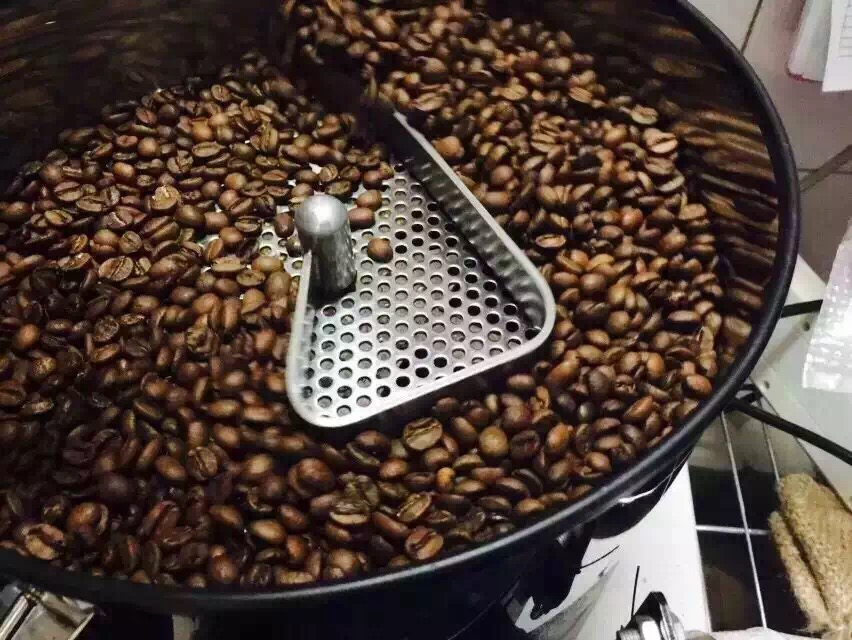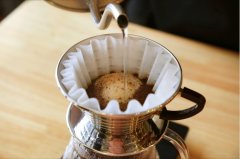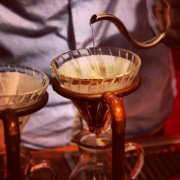The Origin of Vietnamese Coffee the characteristics of Vietnamese coffee

Drinking coffee is a daily habit of Vietnamese. Vietnamese cafes are very common, not high-spending places, and ordinary ones are only a few yuan RMB. Vietnamese coffee is not brewed in a coffee pot, but a special dripping coffee cup, followed by an old-fashioned printed glass, drop by drop to pass the time. When making, put the dripping cup on the cup holder below, put coffee powder in the drip, press a piece of metal with holes, and then brew it with hot water to let the coffee drip into the cup. When making hot coffee, keep the cup warm in a large bowl filled with boiling water, because it may take ten minutes to finish a cup of coffee, and the hot coffee will cool off. Some people like to add a layer of very sweet condensed milk under the cup, wait for the coffee to drop into the cup, and then mix black coffee with white condensed milk to drink, which is extremely sweet. Ice is fine.
The practice of this kind of coffee seems to be found only in Vietnam, and I am afraid that only gentle Vietnamese have such a good temper to wait patiently for a cup of coffee to finish, and then drink it slowly. Even if you pick up coffee on the street by the side of the road, it is the same production procedure and is not ambiguous.
There are so many cafes in Vietnam that people have the urge to open one right away. There are five or six cafes on a small street. The cafes in each city are very different and have their own temperament.
Hanoi's Huanjian Lake is a gathering area of backpackers, surrounded by a lot of beautiful CAFE, with a balcony overlooking the night of Huanjian Lake. The cafes that locals like to patronize usually have a small face. the room is a long, deep strip, with curtains at the door, tables and chairs are short, coffee is very cheap, and a cup of black coffee costs only 5000 guilders. The cafe specially prepared for foreign tourists is different. It is more westernized and the storefront is specially decorated. The price is more than double, but it is still very cheap compared with domestic cafes. Some cafes are opened in a century-old house, where everything is made of wood, with beautiful floors, stairs and tables. You can sit outside and enjoy the street view in the sun, with pink roses on the table. Although such a store knows full well that it costs twice as much, everyone competes to sit there and write postcards and diaries, and no one wants to leave.
The cafes in Saigon are completely different. The tables and chairs face the street, or the house is surrounded by windows extending in all directions. The space is open. The atmosphere in the cafe also seems free and erosive, the coffee is still the same, but the guests all have their own feelings.
The characteristics of Vietnamese Coffee
Flavor [Flavor]: the overall impression of aroma, acidity, and mellowness.
Acidity [Acidity]: the strong acidity of all coffee grown on the plateau. The sour here is different from bitterness and Sour, and has nothing to do with pH value. It refers to a fresh and lively quality that promotes coffee to exert its functions of invigorating the mind and clearing the taste. The acidity of coffee is not the acidity or sour smell of acidity or alkalinity, nor is it an uncomfortable acid that enters the stomach. When making coffee, the performance of acidity is very important. under good conditions and skills, a special taste with fresh acidity can be developed, which is a necessary condition for high-grade coffee. The sour taste of coffee describes a lively, bright flavor, which is somewhat similar to that used in wine tasting. If the coffee bean lacks acidity, it is equal to lose vitality, taste empty and boring, without layer depth. Acidity has many different characteristics, such as coffee beans from Yemen and Kenya, which have an impressive fruity aroma and a red wine-like texture.
Mellow [Body]: the taste of the tongue after drinking coffee. The change of mellowness can be divided into light to light, medium, high, fat, and even Indonesian coffee is as thick as syrup.
Odor [Aroma]: the smell and aroma emitted after the coffee has been prepared. The words used to describe smell include caramel, carbon roast, chocolate, fruit, grass, malt, and so on.
Bitterness [Bitter]: bitterness is a basic sense of taste, and the sensory area is distributed in the base of the tongue. The bitterness of deep baking is deliberately created, but the common cause of bitterness is too much coffee powder and too little water.
Light [Bland]: coffee grown in lowlands, usually quite light and tasteless. Coffee with insufficient coffee powder and too much water will have the same light effect.
Salty [Briny]: after brewing, if the coffee is overheated, it will produce a salty taste.
The aroma of soil [Earthy]: commonly used to describe spicy and earthy Indonesian coffee, not the smell of dirt on coffee beans. Uniqueness [Exotic]: describes coffee with its unique aroma and special flavor, such as flowers, fruits, and spices. Coffee from East Africa and Indonesia usually has this property.
Aromatic alcohol [Mellow]: used to describe coffee with good acidity balance.
Mild [Mild]: used to describe a coffee with a harmonious, delicate flavor, used to refer to all plateau coffee except Brazil.
Soft [Soft]: describes low acidity coffee such as Indonesian coffee, and also describes it as mellow or sweet.
Sour [Sour]: a sense of taste in which the sensory area is mainly located at the back of the tongue and is characteristic of light roasted coffee.
Spice [Spicy]: a flavor or smell reminiscent of a particular spice.
Strong [Strong]: technically, it describes the advantages and disadvantages of various tastes, or the relative ratio of coffee to water in a particular conditioned product. In terms of popular usage, it describes the strong flavor of deep-roasted coffee.
Sweet [Sweet]: in essence, it is like fruit, and it also has something to do with the taste of wine.
Wild [Wild]: describes coffee with extreme taste characteristics.
Wine [Winy]: fruit-like acidity and smooth mellow, created by the contrast of special flavor. Kenyan coffee is the best example of wine flavor.
Note: coffee beans can only be roasted to become coffee beans for grinding and drinking, generally divided into light, medium, deep and extra-deep roasting.
Important Notice :
前街咖啡 FrontStreet Coffee has moved to new addredd:
FrontStreet Coffee Address: 315,Donghua East Road,GuangZhou
Tel:020 38364473
- Prev

The characteristics of Vietnamese coffee the most important characteristics of Vietnamese coffee beans
A new large piece of coffee beans has been added to the home, the original Italian automatic coffee machine. Therefore, recently, I am quite interested in tasting coffee. Coffee beans brought from Germany (middle and high grade in terms of price), strong Italian coffee ground with coffee beans for the first time smells very fragrant, and the strong aroma of coffee makes people want to drink. The original taste is pure, and the entrance has a round feeling. , baking depth
- Next

Coffee production in Vietnam Coffee processing in Vietnam
I. Coffee production in Vietnam the geographical location of Vietnam is very favorable for coffee cultivation. Southern Vietnam has a hot and humid tropical climate, which is suitable for growing ROBUSTA coffee, while the north is suitable for growing ARABICA coffee. Coffee production in Vietnam has the following characteristics: (1) because there is no effective way to deal with fallen leaves, medium-grain coffee was selected as the main variety in the early 1980s.
Related
- Detailed explanation of Jadeite planting Land in Panamanian Jadeite Manor introduction to the grading system of Jadeite competitive bidding, Red bid, Green bid and Rose Summer
- Story of Coffee planting in Brenka region of Costa Rica Stonehenge Manor anaerobic heavy honey treatment of flavor mouth
- What's on the barrel of Blue Mountain Coffee beans?
- Can American coffee also pull flowers? How to use hot American style to pull out a good-looking pattern?
- Can you make a cold extract with coffee beans? What is the right proportion for cold-extracted coffee formula?
- Indonesian PWN Gold Mandrine Coffee Origin Features Flavor How to Chong? Mandolin coffee is American.
- A brief introduction to the flavor characteristics of Brazilian yellow bourbon coffee beans
- What is the effect of different water quality on the flavor of cold-extracted coffee? What kind of water is best for brewing coffee?
- Why do you think of Rose Summer whenever you mention Panamanian coffee?
- Introduction to the characteristics of authentic blue mountain coffee bean producing areas? What is the CIB Coffee Authority in Jamaica?

